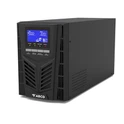
UPS (Uninterruptible Power Supply) and battery backup are often referred to as, or even considered as, the same thing. However, UPS refers to a more advanced version of the backup battery. In other words, all uninterruptible power supplies are battery backed, but have a higher protection rate. Still confused? Read this article to find out the differences between the two devices, which may help you make an informed decision between them.

What is a battery backup? To minimize the harmful effects of power related problems, insert a backup battery into a device, such as a computer. In the event of a surge or power failure, the backup battery will start almost immediately to provide power for the machine for a short time. The battery backup solution provides a good choice to protect your investment in computers and other equipment. The service life of the device depends on the battery size and the power consumption during power failure.

What is an uninterruptible power supply? The "True" UPS has more sophisticated technology in how to use the power supply than the previous conventional battery backup. The UPS supplies power from the battery to the device plugged into the UPS. The power supply charges the battery in standby mode, and the battery supplies power to electronic equipment when necessary. The real UPS always delivers filtered power from the "reservoir" of clean energy, instead of standing by and waiting for power to happen. UPS has more advanced functions, which can prevent power surge, line voltage drop, power failure, power failure and other power problems.

What are the similarities and differences between UPS and battery backup? UPS and battery backup provide almost instant protection for the equipment, minimizing the above losses. However, there are still some differences in functions and types between the two. First, the main difference is the process of filtering power. Power outages, power flashes, and surges do not always trigger the backup battery. However, the UPS filters the power supply to provide a consistent filtering power supply for important equipment that needs to continue to operate and process data. Secondly, the main power supply is AC, while the battery is stored and charged by DC. UPS converts AC power to DC power for charging. When the power supply fails, UPS will convert DC power to AC power again.






